Cai Rang Floating Market: All You Need to Know for an Unforgettable Journey

Characterised by a maze of boats laden with colourful tropical fruits, Cai Rang Floating Market is considered a must for all travellers to the Mekong Delta. What activities can tourists expect to experience in this bustling marketplace? How to make the most of your time exploring the region’s iconic rivers and waterways? Read on to find a good reason to add Cai Rang Floating Market to your bucket list.
Contents
Cai Rang Floating Market History
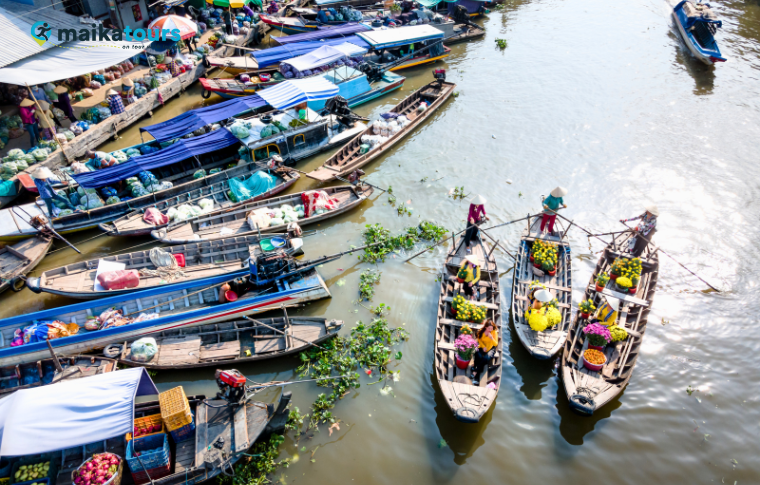
Located on the Can Tho River, near the confluence of the Cai Rang River and Hau River, Cai Rang Floating Market is a typical example of a floating market in the Mekong Delta. The market dates back to the early 20th century, when it became a trading place for local produce. At that time, road transportation was still poor, and the waterways transformed into the main means of delivering goods. Cai Rang Floating Market was among the many floating markets that thrived during that period. In its heyday, it was once the largest rice trading hub in the Western region for the Chinese Vietnamese community.
Over time, Cai Rang Floating Market developed into a trading hub of the region. People started to trade a variety of items, from tropical fruits to regional delicacies. Now, Cai Rang Floating Market serves not only as a commercial centre but also as a unique tourist attraction, highlighting the essence of the Mekong River. The dynamic trading scene makes it a top destination for both locals and visitors.
» See more on Mekong Delta Floating Markets: Unique ‘Floating Experience’
How to Get to Cai Rang Floating Market?
The distance from Ho Chi Minh City to Cai Rang Floating Market is approximately 175 km, equivalent to a 3 – 4 hour road trip. How to visit Cai Rang Floating Market? You can book a package tour including a visit to Cai Rang Floating Market or catch a coach from Ho Chi Minh City (Saigon) to Can Tho.
• Package tour: It is recommended that you book a tour lasting at least 3 days to have enough time for all essential experiences. You will depart from Ho Chi Minh City and travel to some other parts of the Mekong Delta before reaching Can Tho to see the floating market.
• Coach options: The journey typically lasts 3-4 hours, with the fare at around VND 150,000 – 350,000, depending on the type of coach. For departure, head to Mien Tay Bus Station to buy your tickets or you can visit vexere.com to reserve a seat. There are many options to choose from, standard sleeper buses, Limousine buses, and VIP cabin buses. Please check the pick-up and drop-off option carefully before you proceed with the booking.
Is Cai Rang Floating Market Worth Visiting?
If you choose to visit the Mekong Delta for its exceptional river life, then Cai Rang Floating Market is an unmissable part that offers a glimpse into that uniqueness. You can take this great opportunity to observe how locals earn a living and make the best use of their local resources.
Cai Rang Floating Market is more than just an ordinary tourist attraction – it is deeply woven into the fabric of local culture. The market has the power to connect people and shape their way of life, so this is exactly where you can find the liveliest and most authentic atmosphere of the region. A visit to Cai Rang Floating Market promises to let you step back in time to learn about Can Tho’s past and how old traditions are kept alive. While enjoying freshly served seafood, tropical fruits, and classical Mekong Delta dishes, you can snap vibrant colours, traditional outfits, and action-packed moments.
Visiting Cai Rang Floating Market is a must-do experience for anyone looking to dive deep into the local atmosphere and explore the unique traditions of river-based life.
» See more on Cu Chi and Mekong Delta Tour: Two Destinations for an Immersive Day
Things to do at Cai Rang Floating Market
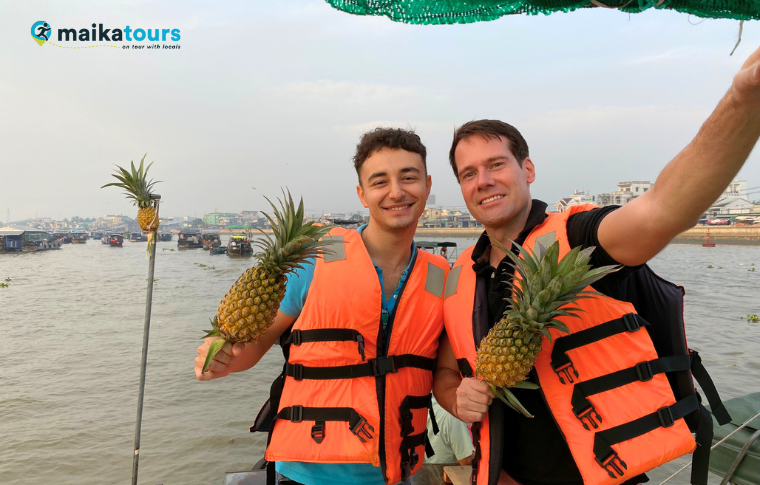 What can you do at Cai Rang Floating Market? Like any other traditional wet market, Cai Rang offers a variety of goods, deliciously prepared dishes, and countless items that can amaze any traveller. Here are a few things to try when you visit Cai Rang Floating Market in the Mekong Delta:
What can you do at Cai Rang Floating Market? Like any other traditional wet market, Cai Rang offers a variety of goods, deliciously prepared dishes, and countless items that can amaze any traveller. Here are a few things to try when you visit Cai Rang Floating Market in the Mekong Delta:
1. Explore an intriguing local way of trade
Cai Rang Floating Market is famed for its vibrant scene that reflects the essence of trading culture in the Mekong Delta. At this market, local vendors come up with a creative idea to promote their goods – displaying a sample of the item for sale atop a tall bamboo pole. This practice allows for a better promotion method than the traditional way when the shouts of the sellers are easily muffled by the noise of the boat engines. You can also see the goods from afar, so it will be much easier to identify which boat offers the items you are seeking.
To fully explore the floating market, the only way is to rent a boat to get around. The prices depend on the route you choose to visit, the travel time, and the number of people in your group. Tourists usually pay from VND 500,000 to VND 2,000,000 for the market boat tour.
2. Savour local delicacies
The Mekong region in general, and Can Tho in particular, is blessed with endless specialties and fresh produce that have never failed to satisfy even the most discerning palates. The scene at Cai Rang Floating Market is highlighted by traditional boats laden with tropical fruits, vegetables, and ready-to-eat dishes. Your epicurean journey can start with a fruit tasting and then round out with a hearty main course.
From rambutan, jackfruit, and mango to pineapple, to name but a few to rock your taste buds. The diversity of colours, shapes, and textures also make them more tempting to try. You can dip your favourite piece into local dried shrimp salt to add an extra interesting flavour. If you want to try something out of the ordinary, why not sample a piece of durian? Its strong odour is something that you will either love it or hate it.
For a comforting hot bowl, you can ask for noodle soups like hủ tiếu or bún riêu. Try the special eating style that you can find nowhere else – eating on a moving boat. You can admire the lively scene at Cai Rang Floating Market while slurping hot noodles and sipping on iced milk coffee.
3. Interact with local vendors
In addition to authentic delicacies, the Mekong Delta leaves a lasting impression on visitors with its hospitality. Travelling to this region, you won’t find it hard to befriend amiable locals whose smiles can warm you up right after the encounters. Despite their broken English, they have plenty of interesting stories to tell about their daily lives, family traditions, and how they preserve their cultural heritage.
It goes without saying that local vendors know the best way to enjoy the Mekong specialties. Don’t hesitate to ask them how to enjoy a specific type of fruit or noodles, and they will happily tell you useful tips and even interesting stories behind each flavour.
Useful Tips for Travellers
Visitors opting for a trip to the Mekong Delta and Cai Rang Floating Market won’t find it difficult to blend in the local liveliness. Taking into consideration some factors relating the market’s opening hours or the best time to visit can make your experience more satisfying.
• Opening hours: The market is typically open from 5 a.m. to 9 a.m., and the best time to visit is between 5.30 a.m. and 6.30 a.m. – the busiest period, when you can experience the market at its most vibrant.
• Ticket price and boat fare: There is no entrance fee to visit Cai Rang Floating Market; however, you need to rent a boat to get around the market area. The rental rate varies depending on the number of guests and the travel time. If you master the art of negotiation, you can get a better deal for your group.
• Local communication: Local vendors are very welcoming, and they also enjoy engaging with friendly visitors in return. Injecting a bit of humour into the conversation can make everyone feel relaxed, and a compliment for the goods always leaves a good impression on the seller.
What to eat at Cai Rang Floating Market?
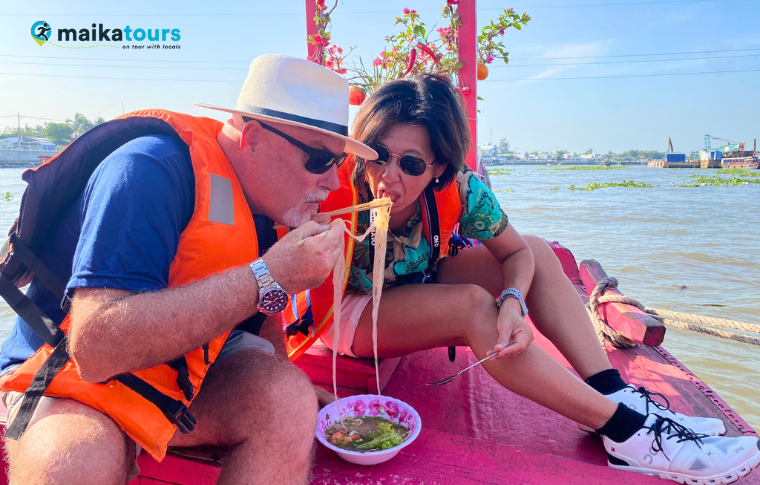 The Mekong Delta takes pride in its diverse cuisine that has never failed to capture the hearts of visitors worldwide. The must-try dishes in the Mekong Delta boast fresh ingredients, rich in nutrients, and bursting with authentic local flavours.
The Mekong Delta takes pride in its diverse cuisine that has never failed to capture the hearts of visitors worldwide. The must-try dishes in the Mekong Delta boast fresh ingredients, rich in nutrients, and bursting with authentic local flavours.
1. Hủ tiếu
With roots in both Cambodian and Chinese flavours, hủ tiếu is a popular dish in southern Vietnam, especially in the Mekong Delta. A bowl of hủ tiếu is typically made up of rice noodles, pork, seafood, and many other types of toppings. Just as enjoying hủ tiếu on land, you can taste the best of hủ tiếu on the river with some extra green herbs and chili sauce. Enjoying hủ tiếu for your breakfast promises to elevate your culinary experience and fill the rest of your day with joyful energy.
2. Bánh xèo
The name of the dish, Bánh xèo, can be translated as ‘sizzling pancake,’ referring to the sound it makes when the batter hits the hot pan. Bánh xèo is loved by many food lovers for its balanced flavours, crispy texture, and nutritious fillings. This special dish contributes to the diverse scene of the Mekong cuisine and is a must-try dish for anyone visiting the Cai Rang Floating Market. Don’t forget to dip the roll into the sweet and sour fish sauce to enhance its flavours.
3. Bún riêu
The Vietnamese crab noodle soup is a mouth-watering combination of fresh crab, rice vermicelli, and aromatic spices that create a unique symphony of flavours. A defining characteristic of the dish is its crab meat and crab broth, which are deeply flavourful. While bún riêu can be found in many other parts of the country, it is only in the Mekong Delta that visitors find its uniqueness, thanks to fresh local produce and a special cooking method.
4. Cơm tấm
The Vietnamese, particularly those living in the Mekong Delta, delicately take advantage of the broken rice and make it into a delicious dish of cơm tấm. In the late 19th century, broken rice became a staple food among poor farmers in the Mekong Delta. Later, in the first half of the 20th century, cơm tấm was popular in the southern region. Now, the most typical toppings for cơm tấm are chargrilled pork chops, shredded pork skin, and steamed egg meatloaf. The add-ons are also varied, including scallion oil, vegetables and pickles, all well dipped into the savoury sauce to add an extra flavour.
5. Bánh mì
The Vietnamese baguette is consistently ranked among the best street foods in Vietnam, and you can enjoy a signature taste of bánh mì in the Mekong Delta. Bánh mì is not only favoured for its taste but also attracts customers thanks to its affordable price. You can choose from various fillings to satisfy your taste buds: ham, shredded pork skin, pork roll, pork sausage, grilled chicken, and many more.
Other Must-See Attractions
Can Tho is well-known for its lively waterways and age-old customs. In addition to Cai Rang Floating Market, you can learn more about the region’s history and culture at the following sites.
1. Ninh Kieu Wharf
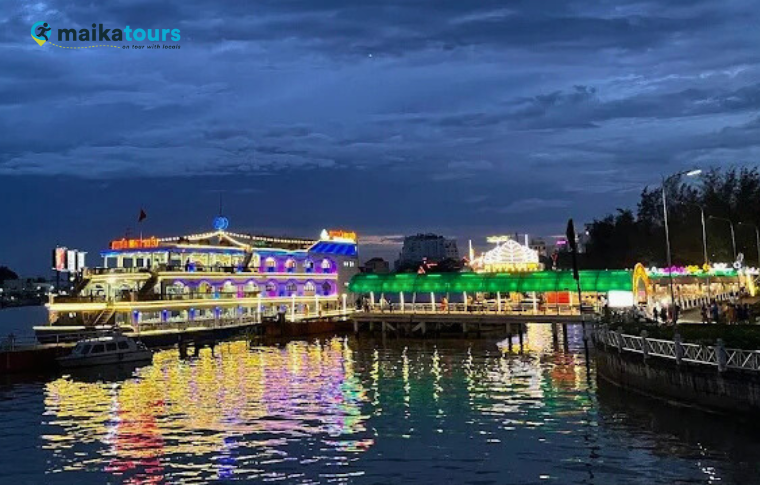 Ninh Kieu Wharf is one of the iconic tourist attractions in Can Tho. From the wharf, you can take in beautiful views of the Hau River and explore the nightlife at its best. The wharf is located roughly 7 km away from the city centre, and you can easily get there by taxi. The highlight of Ninh Kieu Wharf is its strikingly curved pedestrian bridge that connects Cai Khe Islet to Ninh Kieu Wharf. Take an evening stroll across the bridge at night when it is beautifully lit up with colourful LED bulbs.
Ninh Kieu Wharf is one of the iconic tourist attractions in Can Tho. From the wharf, you can take in beautiful views of the Hau River and explore the nightlife at its best. The wharf is located roughly 7 km away from the city centre, and you can easily get there by taxi. The highlight of Ninh Kieu Wharf is its strikingly curved pedestrian bridge that connects Cai Khe Islet to Ninh Kieu Wharf. Take an evening stroll across the bridge at night when it is beautifully lit up with colourful LED bulbs.
If you look for a relaxing experience, don’t miss the dinner cruise to admire the beauty of Can Tho by night. This is a great opportunity for you to savour local delicacies and revel in a fascinating performance of Vietnamese folk songs.
2. Rice Noodle Factory
Can Tho offers various specialties that can tell the story of the land and the everyday life of locals. You can opt for a visit to Sau Hoai Rice Noodle Factory to see how locals make various products from the region’s treasure – rice. Understand all the steps involved in making traditional Vietnamese rice paper, rice noodles, and their special product – Hủ tiếu pizza (rice noodle-style pizza). Don’t forget to shop for some local souvenirs from this factory to take home with you.
3. Can Tho Night Market
The night market contributes to the lively scene in Can Tho. Within walking distance from Can Tho Wharf, Can Tho Night Market invites you to the world of bustling trading and recreational activities. You can find a rich selection of items, from traditional crafts and street food to everyday essentials and charming souvenirs. The market opens daily from 5 p.m. to 12 a.m., making it an ideal rest stop for evening wanderers to shop and enjoy culinary delights.
4. Binh Thuy Ancient House
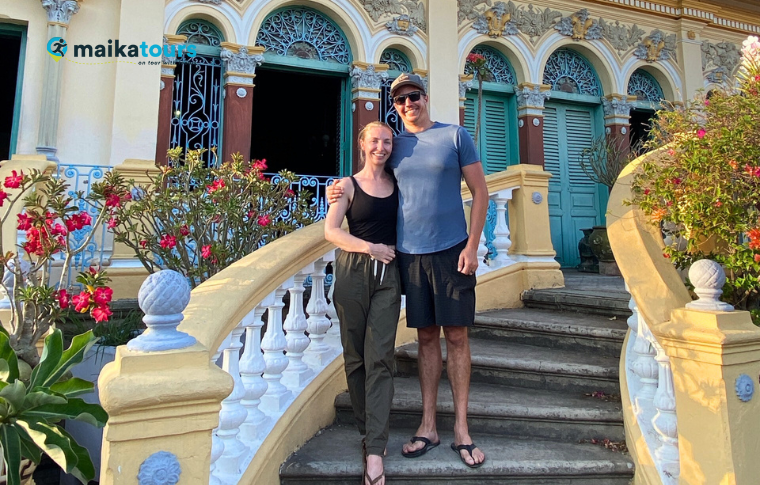 The Mekong Delta is famed for its exquisite ancient houses, and Binh Thuy Ancient House is a typical example of the local architecture and heritage. Besides Cai Rang Floating Market and Ninh Kieu Wharf, you can find the truest Mekong Delta at Binh Thuy Ancient House. One of the few remaining houses that combine French, Chinese, and Vietnamese architectural principles, the house was initially built as a place of worship for a local wealthy family.
The Mekong Delta is famed for its exquisite ancient houses, and Binh Thuy Ancient House is a typical example of the local architecture and heritage. Besides Cai Rang Floating Market and Ninh Kieu Wharf, you can find the truest Mekong Delta at Binh Thuy Ancient House. One of the few remaining houses that combine French, Chinese, and Vietnamese architectural principles, the house was initially built as a place of worship for a local wealthy family.
Visiting this ancient house is not only about admiring its architecture, but you also get close to nature. The ancient house is surrounded by well-kept bonsai trees and flowers blooming all year round. The peaceful garden setting makes it perfect for a quiet retreat or a leisurely afternoon stroll.
5. Binh Thuy Temple
An underrated place of interest in Can Tho, Binh Thuy Temple is an embodiment of charming Vietnamese-Chinese fusion highlighting Mekong’s architectural feature. Just 7 km from Can Tho Wharf and 2 km from Binh Thuy Ancient House, Binh Thuy Temple can be easily added into your day tour exploring Can Tho City. If your trip coincides with a special occasion, you can also join the local festivals to understand more about the spiritual life of local people. You will find many interesting rituals such as offering sacrifices, inviting deities, and presenting a traditional Vietnamese “hat boi” performance.
Visiting Cai Rang Floating Market is not just about experiencing a shopping scene on the water, but about connecting with local vendors to learn about their unique ways of life. Contact us now for a fully customisable tour to uncover the charm of the Mekong Delta’s waterways and savour the best local delicacies.